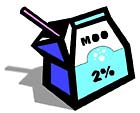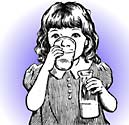|
My illness is due to my doctor’s insistence that I drink milk, that whitish fluid they force down the throats of helpless babies. – W.C. Fields
"Got milk" is the question of the day among Hollywood’s upper crust, whose smiles across the television screen bear telling white moustaches above elitist lips. Simultaneously, vegan activists denounce cow’s milk as unhealthy and tainted by antibiotic residues, hormones and genetically modified organisms. They may have their point, but it gets drowned under the sea of Madison Avenue’s forceful influence. Is milk food or poison? What is the truth about this champion of nutrition, justice and the American way? (Or was that all about Superman who drank no milk at all?) Like it or not, milk has become, more than any other food, a symbol of wholesome goodness and bucolic purity. How did this happen and should we be happy about it?
 Milk is one of the oldest known foods and its nutritional value has long been common knowledge. There are records of cows being milked as far back as 9000 BC and milk is mentioned 47 times in the Old Testament of The Bible. (This is evidenced by dusty bibles found in the drawers of even dustier, ancient hotel rooms.) The first dairy cattle to come to America traveled with Christopher Columbus on his second voyage to the New World in 1493. He didn’t bring any cows with him on his first voyage and the lack of milk was said to have contributed to the high death rate, particularly of the young cabin boys. When the pilgrims crossed the Atlantic, it became English law that each ship destined for The New World had to carry one cow for every five passengers on board. When the ship arrived in port, the captain had the perogative to sell the cattle and thereby earn some income. (God knows what the salary was in those days for a man who could identify the North Star!) Milk is one of the oldest known foods and its nutritional value has long been common knowledge. There are records of cows being milked as far back as 9000 BC and milk is mentioned 47 times in the Old Testament of The Bible. (This is evidenced by dusty bibles found in the drawers of even dustier, ancient hotel rooms.) The first dairy cattle to come to America traveled with Christopher Columbus on his second voyage to the New World in 1493. He didn’t bring any cows with him on his first voyage and the lack of milk was said to have contributed to the high death rate, particularly of the young cabin boys. When the pilgrims crossed the Atlantic, it became English law that each ship destined for The New World had to carry one cow for every five passengers on board. When the ship arrived in port, the captain had the perogative to sell the cattle and thereby earn some income. (God knows what the salary was in those days for a man who could identify the North Star!)
In 1611 cows arrived in the Jamestown colony. Among the first laws written by its governor, Lord Delaware, were several protecting cows. Prior to their arrival in the Plymouth colony, the lack of milk contributed to the high mortality rate, especially among the children. Today, in Boston, Massachusetts, there is a large park called The Commons. It was once a community pasture where cows from throughout the settlement were brought to graze. This pasture is a living memorial to the cows that arrived in Plymouth in 1624 bringing new hope to the hungry colonists.
From their earliest beginnings in America, dairy cattle spread through the new land. When the West was settled, the family cow was tied behind the covered wagon, providing milk and butter all along the arduous way. Prior to the nineteenth century, drinking milk presented many health risks. Straight from the cow, it was loaded with bacteria. If I wasn’t consumed within a matter of hours in summer, it was spoiled by the heat and there were a combination of illnesses allegedly derived from milk consumption. These included: milk sickness, milk poison, the slows, the trembles and the milk evil. Granted some of these illnesses were probably not due to milk or to the milk alone, but the stigma persisted.
Until the early 1800’s most milk peddled by milkmaids through city streets was buttermilk, a byproduct of the butter-making industry. It was not a common beverage and most of it was fed to hogs. By the 1850’s, however, a significant drop in breast-feeding gave rise to the use of cow’s milk for human consumption. The growing demand launched the fledgling dairy industry which Temperance supporters embraced in their efforts to shut down New York distilleries. These distilleries disposed of the grain used for fermentation by feeding the leftover "slop" to cows. The poorly nourished animals produced a low quality milk and temperance leaders lobbied to move dairy operations outside of the city "for the well-being of the children." A political cartoon from the era depicts a dying cow, too weak to even stand, being milked as it is suspended from rafters.
Milk changed its face completely in 1856 both with the advent of condensed milk and the scientific genius of Louis Pasteur. In that year, Gail Borden received the first patent on condensed milk and Pasteur’s experiments on bacteria began, resulting in the process that still bears his name (pasteurization). The idea of a portable canned milk product came to Mr. Borden during a transatlantic voyage in 1852. The cows in the hold became too seasick to be milked and one infant on board died from lack of milk. His original condensed milk product lasted three days without souring. He first thought that the condensing process made the milk more stable, but later realized that it was the heating process that killed the bacteria that caused spoilage. Sugar was added to inhibit bacterial growth and skim milk was used. Use of this version devoid of nutrients, was later blamed for a rash of rickets cases in 1905.
 By the late 1800’s, social activists focussed on public health and sanitation, called for the pasteurization of milk and inspection of dairy farms as part of their vision of a perfect society. Progressive era reformers sought efficient, large-scale milk production and a state-of-the-art transportation system to link rural dairies with populous urban areas. In the early 1900s both condensed and evaporated milk were used more than fresh milk because they were more shelf stable and posed less of a health risk. This was before the government enacted laws to insure the safety of fresh milk, not to mention refrigerators as standard equipment in every kitchen. The demand for milk soared during World War One and American milk drinking rose steadily until World War II, except during the Depression when consumption fell dramatically, triggering strikes that led to milk-related New Deal legislation. Today, Americans drink less milk but eat increasingly larger amounts of manufactured milk products like cheese, yogurt and ice cream. By the late 1800’s, social activists focussed on public health and sanitation, called for the pasteurization of milk and inspection of dairy farms as part of their vision of a perfect society. Progressive era reformers sought efficient, large-scale milk production and a state-of-the-art transportation system to link rural dairies with populous urban areas. In the early 1900s both condensed and evaporated milk were used more than fresh milk because they were more shelf stable and posed less of a health risk. This was before the government enacted laws to insure the safety of fresh milk, not to mention refrigerators as standard equipment in every kitchen. The demand for milk soared during World War One and American milk drinking rose steadily until World War II, except during the Depression when consumption fell dramatically, triggering strikes that led to milk-related New Deal legislation. Today, Americans drink less milk but eat increasingly larger amounts of manufactured milk products like cheese, yogurt and ice cream.
Milk is one of the most valuable of all foods. One of the most important nutrients derived from it is protein. It is also a source of calcium, vitamin D and B vitamins. Phosphorus is another mineral milk provides in large quantities. It combines with the calcium to build and maintain healthy bones. Activists claim that adults need milk as well as children and that it should always be included in a weight reduction program. They also state that the caloric content is the same in butter and other commonly used table fats such as margarine, and that the important nutrients in milk and meat are not influenced by the feed of the animal. Most of this may be true, but in all fairness, we must now consider the other side of the issue as presented by PETA (People for the Ethical Treatment of Animals) and Robert Cohen, author of Milk: The Deadly Poison and promoter of the web site, NotMilk.com.
|